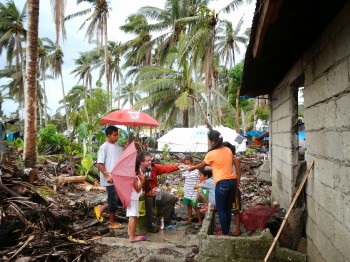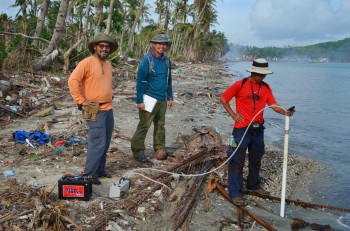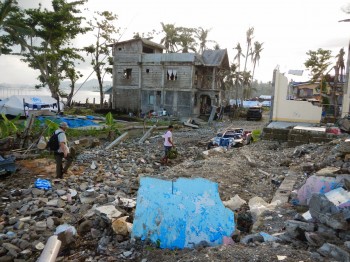Typhoon Haiyan’s Storm Surge May Contaminate Aquifer for Years
April 14, 2015

In research of significance to the world’s expanding coastal populations, scientists have found that geology and infrastructure play key roles in determining whether aquifers that provide drinking water are inundated with seawater during a typhoon or hurricane and how long the contamination lasts.
In 2013, Typhoon Haiyan devastated the Philippines, killing more than 6,000 people and destroying nearly $3 billion worth of property. While the country is still recovering from the storm, researchers with The University of Texas at Austin have found that an aquifer on the island of Samar inundated with salt water by the storm surge could remain undrinkable for up to 10 years. But a second aquifer on the island that was also inundated has recovered much more quickly.
The research was published online April 14 in the journal Geophysical Research Letters. It focused on aquifers used by the village of San Antonio on the island of Samar.
The difference in recovery time is due to the two aquifer’s surrounding geology, said Bayani Cardenas, an associate professor in the Department of Geological Sciences in the Jackson School of Geosciences, who led the research team. The shallower of the two aquifers is made up of beach sand about 10-15 feet deep, which allowed the salt water soaked up from the surge to percolate to the water table and move through the aquifer for years to come. In contrast, the other aquifer is largely shielded from seepage because of its depth and possibly an overlying layer of volcanic rock.
“There are two types of aquifers, contaminated in two different ways,” Cardenas said.
The findings are an important insight into what makes aquifers vulnerable to storm surge contamination and contamination’s lasting effects, a topic that’s expected to become especially important to coastal populations as storms become stronger and more frequent because of climate change, Cardenas said.

“Typically, when people think of flooding or sea level rise, they look at how it’s going to drown out villages and roads, but all these effects propagate underground where the aquifers are,” Cardenas said.
The UT Austin team also included geosciences professor Philip Bennett and graduate students Peter Zamora, Kevin Befus, Matt Kaufman and Aaron Jones. The team collaborated with Raymond Rodolfo, Hillel Cabria and Mark Lapus from a Filipino environmental consulting company, a local aid group, and leaders and residents from the village.
Sponsored in part by the Jackson School’s rapid response program, a fund that supports research in areas recently affected by natural disasters, the researchers arrived in San Antonio two months after the storm struck. The team took water samples from dozens of village wells that tapped into the aquifers.
The researchers found the wells contained a median seawater concentration of 4.5 percent, with some containing as much as 17 percent seawater. In comparison, U.S. environmental standards set the concentration for drinking water below 1.3 percent.
When the team returned six months later, thanks to support from the U.S. National Science Foundation, researchers found the salinity of the deeper aquifer was within drinkable levels, while wells to the shallower aquifer remained too salty to drink. Using a computer model and villager testimony, researchers determined that water reached the aquifers in different ways.

For the deeper aquifer, the contamination most likely came from salt water entering through wells flooded by the storm surge. However, the fact that the contamination came all at once enabled it to be mostly swept out of the area en masse by freshwater naturally flowing through the aquifer and out to sea. The majority of the village’s wells tap into the deeper aquifer, where water salinity now is largely within drinkable levels. However, bacterial contamination, which the storm surge may have contributed to, remains an issue.
For the shallower aquifer, the model showed contamination is occurring in gradual doses, as the saltwater seeps through the sand to the water table.
“It slowly percolates,” Cardenas said. “So that’s the one that will take longer to recover.”
The saltwater may also reach the deeper aquifer through percolation, but it will be at more dilute concentrations.
These findings show that coastal aquifers — and the people who depend on them — could be at risk of contamination in future storms.
“Since growing coastal populations will continue to rely on groundwater for their needs, strategies for reducing vulnerability to intense storm surge-caused groundwater contamination and mitigating its effects are needed,” the researchers stated in the study. “Below-ground aquifer devastation from storm surge is unseen but need not be unforeseen.”
The research can be read here.
For more information contact: Anton Caputo, UT Jackson School of Geosciences communications director, 512-232-9623; or Monica Kortsha, UT Jackson School of Geosciences public affairs officer, 512-471-2241.
